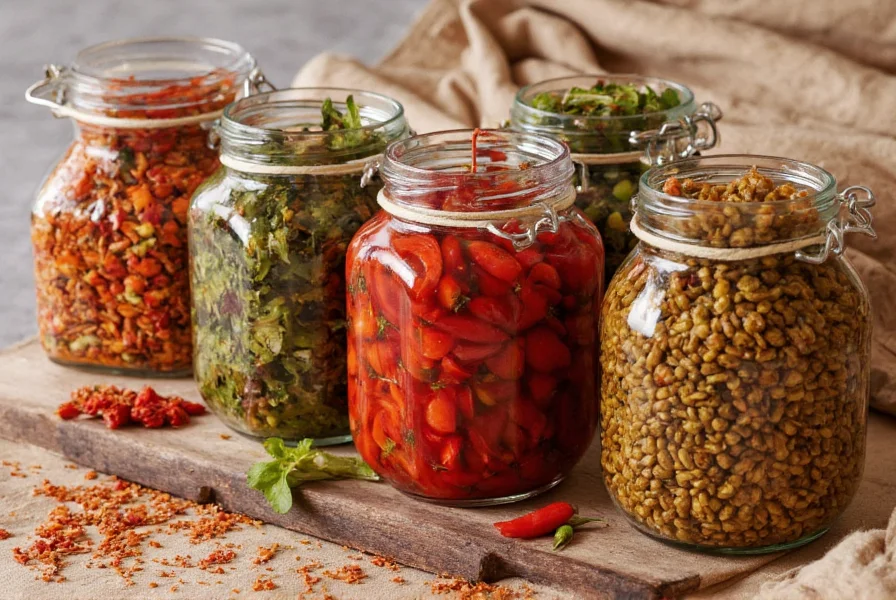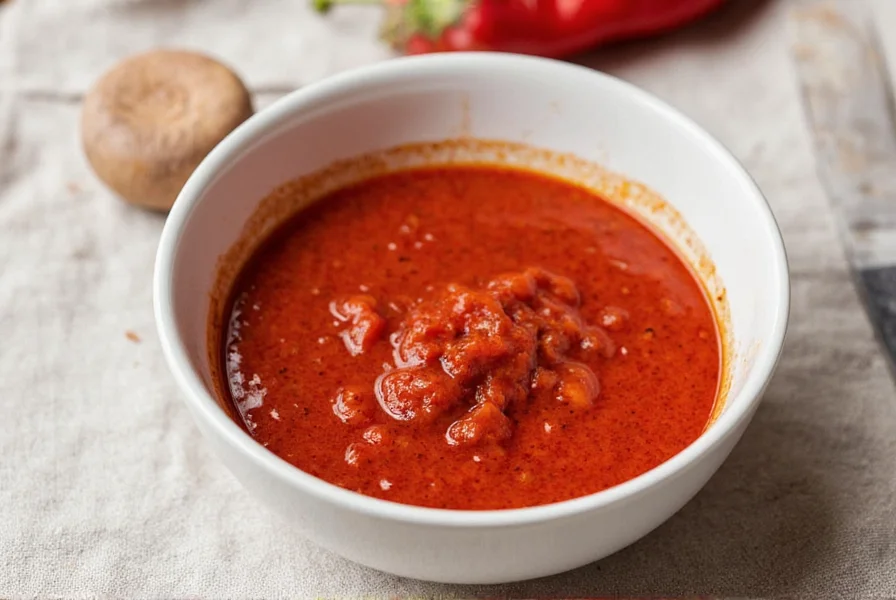Understanding pimento pepper alternatives is essential for home cooks facing recipe challenges. Pimento peppers, known for their vibrant red color and sweet, mild flavor with just a hint of heat (measuring 100-500 on the Scoville scale), appear in numerous dishes from stuffed olives to cheese spreads. When you can't find authentic pimentos, knowing the right substitute prevents recipe failures and maintains dish integrity.
What Makes Pimento Peppers Unique
Pimento peppers (Capsicum annuum) feature a distinctive heart shape, deep red hue when mature, and remarkably sweet flavor profile. Unlike many peppers, they contain minimal capsaicin, making them approachable for heat-sensitive palates. Their thick walls and high moisture content create ideal texture for stuffing, roasting, and blending into smooth spreads. Commercially, most "pimento" products actually use red bell peppers due to pimentos' short growing season and labor-intensive harvesting.
Top 5 Pimento Pepper Substitutes Ranked
Not all alternatives work equally well across recipes. Consider these factors when selecting a pimento pepper replacement: sweetness level, moisture content, wall thickness, and intended cooking method. Here's how common substitutes compare:
| Substitute | Flavor Match | Texture Match | Best Recipe Applications | Substitution Ratio |
|---|---|---|---|---|
| Red Bell Pepper | 9/10 | 8/10 | Stuffed peppers, salads, sandwiches | 1:1 fresh |
| Roasted Red Peppers | 8.5/10 | 7/10 | Dips, sauces, spreads | 1:0.75 (drained) |
| Mild Paprika | 7/10 | N/A | Seasoning blends, dry rubs | 1 tsp = 1 small pimento |
| Cherry Peppers | 8/10 | 9/10 | Stuffed olives, pickled applications | 1:1 whole |
| Pepperoncini | 6/10 | 7/10 | Pickled dishes, Mediterranean recipes | 1:1 (rinse first) |
Best Pimento Pepper Alternatives Explained
Red Bell Peppers: The Closest Fresh Alternative
When seeking a pimento pepper fresh substitute, red bell peppers provide the most comparable flavor profile. Their sweetness develops fully when left to ripen to deep red on the vine. For optimal results, remove seeds and membranes before dicing. This substitute for pimento peppers in stuffed dishes works perfectly in recipes like pimento cheese or deviled eggs. Roast them briefly to enhance sweetness when replicating jarred pimentos.

Roasted Red Peppers: Ideal for Spreads and Dips
For recipes requiring the characteristic smooth texture of jarred pimentos, roasted red pepper substitute for pimento delivers excellent results. The roasting process concentrates natural sugars, mimicking pimentos' signature sweetness. Drain thoroughly and pat dry before use to prevent watery textures in cheese spreads. This alternative works particularly well as a pimento cheese substitute ingredient in Southern-style recipes.
Mild Paprika: The Dried Option
When your recipe calls for dried pimento powder (common in Spanish cuisine), mild paprika serves as the most appropriate pimento powder substitute. Hungarian sweet paprika offers the closest flavor match without heat. Use 1 teaspoon paprika for every small fresh pimento called for in seasoning blends. Avoid smoked paprika unless the recipe specifically requires that flavor note.
Cherry Peppers and Pepperoncini: Specialty Substitutes
For specific applications like stuffed olive pimento substitute, cherry peppers provide similar size and shape. Their slightly more pronounced flavor works well in pickled applications. Pepperoncini offer a tangier alternative with minimal heat, making them suitable for Mediterranean dishes where pimentos traditionally appear. Rinse pepperoncini thoroughly to reduce vinegar flavor before substituting.

Recipe-Specific Substitution Guidelines
Successful substitution depends on understanding your recipe's requirements:
Pimento Cheese Recipe Adjustments
When making pimento cheese without pimentos, use roasted red peppers for creamier texture. Drain and squeeze out excess moisture, then finely chop. For every 1 cup jarred pimentos, substitute 3/4 cup roasted red peppers plus 1/4 teaspoon sugar to compensate for reduced sweetness. This pimento cheese spread substitute maintains the traditional flavor profile.
Stuffed Pepper Modifications
For stuffed peppers substitute for pimento applications, red bell peppers work best. Choose smaller specimens that can stand upright. Reduce cooking time by 10-15 minutes compared to recipes using authentic pimentos, as bell peppers maintain structure longer. Add 1 tablespoon tomato paste to the filling to enhance color.
Pickling and Preserving Considerations
When creating pickled pimento substitute applications, cherry peppers provide the most authentic experience. Their thin walls absorb brine effectively. Use a 50:50 mixture of white vinegar and water with 1 tablespoon pickling spice per pint jar. Process for 10 minutes in a water bath canner for safe preservation.
Common Substitution Mistakes to Avoid
Many home cooks make these critical errors when seeking pimento pepper alternatives:
- Using spicy peppers like jalapeños as pimento pepper replacement for mild recipes
- Skipping moisture removal with roasted pepper substitutes, causing watery dishes
- Substituting green bell peppers, which lack the necessary sweetness
- Using hot paprika instead of mild when a dried substitute is needed
- Not adjusting cooking times when substituting different pepper varieties
When Substitution Isn't Possible
Certain specialty applications like traditional Spanish pimento-stuffed olives have no perfect substitute. In these cases, consider modifying the entire recipe. For example, replace pimento-stuffed olives with garlic-stuffed or lemon-zest-stuffed alternatives that maintain the visual contrast while providing complementary flavors. This approach works well as a pimento stuffed olive substitute in martini preparations or tapas platters.
FAQ Section
Can I use regular bell peppers as pimento substitute in pimento cheese?
Yes, red bell peppers make an excellent pimento cheese substitute. Use roasted red bell peppers for best results—drain thoroughly and chop finely. For every cup of jarred pimentos, substitute 3/4 cup roasted red peppers plus 1/4 teaspoon sugar to match the sweetness level. This maintains the traditional texture and flavor profile of authentic pimento cheese.
What's the best substitute for pimento peppers in stuffed olives?
Cherry peppers serve as the closest substitute for pimento peppers in stuffed olives due to their similar size and mild flavor. If unavailable, small strips of roasted red bell pepper work well. For best results, cut the substitute pepper into thin strips that match the olive's diameter, and briefly blanch to soften before stuffing. This creates an authentic-looking and tasting pimento stuffed olive alternative.
How do I substitute pimento peppers in a recipe that calls for dried pimentos?
For dried pimento applications, use mild Hungarian paprika as your primary substitute. The conversion ratio is 1 teaspoon paprika for every small fresh pimento called for in the recipe. If the recipe requires whole dried pimentos (less common), substitute dried cherry peppers or small dried red bell peppers, rehydrating them in warm water for 20 minutes before use. This dried pimento pepper replacement works well in Spanish and Mediterranean spice blends.
Can I use banana peppers as a pimento substitute?
Banana peppers can work as a pimento substitute in some applications but require caution. They're slightly tangier and can have more heat than traditional pimentos. For fresh applications like salads or sandwiches, use them raw. For cooked dishes, roast first to mellow the flavor. This pimento pepper alternative for mild recipes works best when you select the sweetest, reddest banana peppers available and remove seeds thoroughly.
Why do some recipes specify pimento peppers instead of regular bell peppers?
Recipes specify pimento peppers for their distinctive sweet flavor, thinner walls, and traditional use in certain dishes like Spanish pimento-stuffed olives or classic Southern pimento cheese. While red bell peppers often substitute well, authentic pimentos have a more concentrated sweetness and slightly different texture. In commercial production, most "pimento" products actually use specially cultivated red bell peppers due to pimentos' limited growing season and higher production costs.











 浙公网安备
33010002000092号
浙公网安备
33010002000092号 浙B2-20120091-4
浙B2-20120091-4